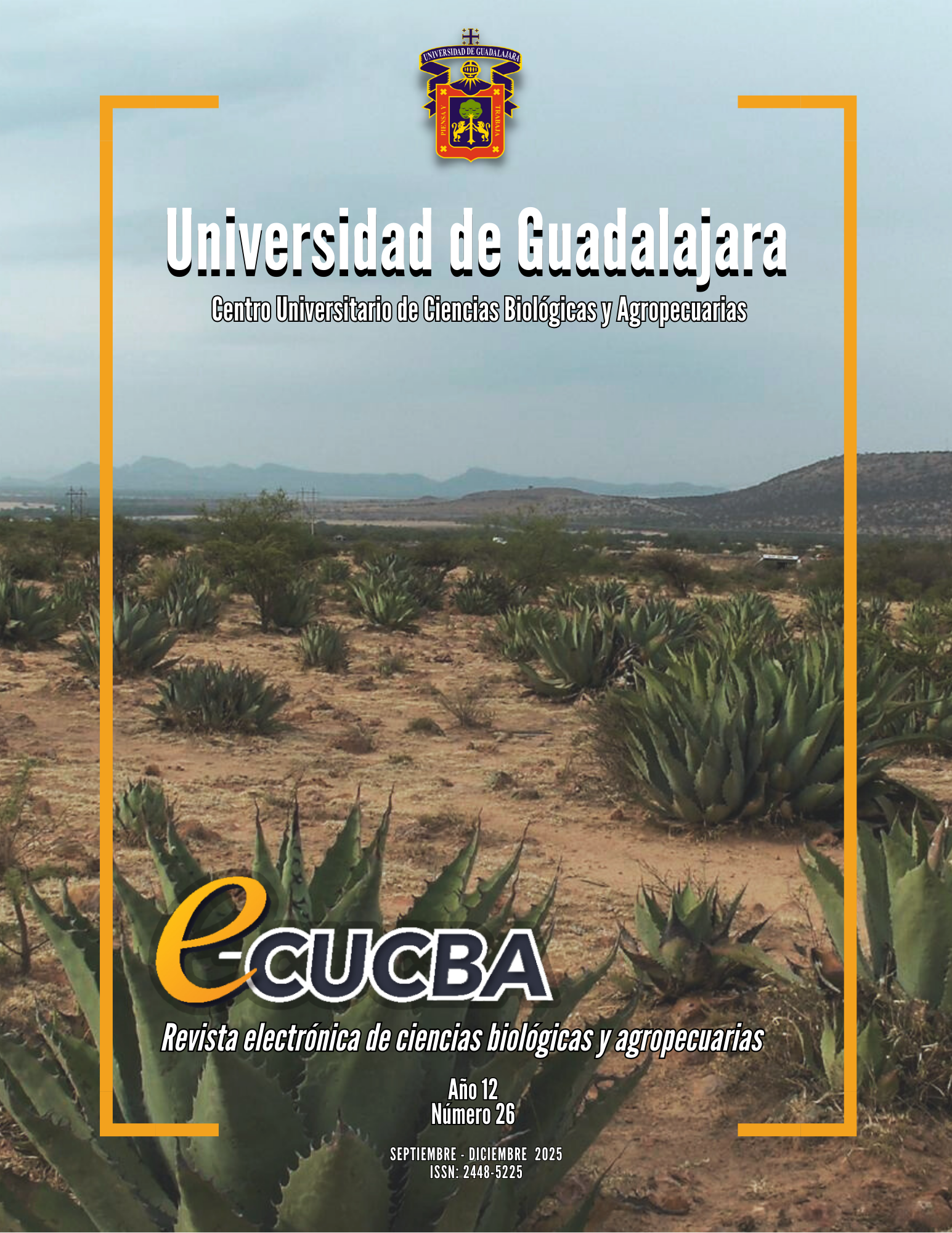Characterization of strains of pleurotus djamor obtained by dicarion-monocaryon crossing
Characterization of strains of pleurotus djamor obtained by dicarion-monocaryon crossing
DOI:
https://doi.org/10.32870/e-cucba.vi26.400Keywords:
Mejoramiento genético, bagazo de agave, Fenómeno Buller, hongo comestibleAbstract
Buller phenomenon consists of the dikaryoticization of monokaryotic mycelia by dikaryonic mycelia, was first observed in Coprinus lagopus and Schizophyllum commune to determine incompatibility factors and understand the processes of nuclear migration and clamp formation, but it has not been used as a genetic improvement strategy in Pleurotus. The objective of the proposed work was to obtain and characterize di-monokaryonic strains of P. djamor native to Jalisco and their cultivation in tequila agave bagasse. To achieve this, the dikaryoticization of monosporic mycelia was studied by means of dikaryotic mycelia of three wild P. djamor strains from the state of Jalisco. A total of 9 di-monokaryonic strains were obtained. Each strain obtained was evaluated for its performance in EMA and HIT culture media, with the latter being the most suitable and therefore suitable for use in the management of these strains. Regarding agave carpophore production, it was determined that they can reach up to 39% biological efficiency in fresh and 4.9% in dry media. Furthermore, an average commercially suitable carpophore size of 5 to 11 cm was established, resulting in percentages ranging from 77% to 47% in the hybrid strains obtained.
References
Ahmad, I., Fuad, Z. K. K., y Khan, I. (2015). Mycelia Growth of Pink Oyster (Pleurotus djamor) Mushroom in Different Culture Media y Environmental Factors. Agriculture and Food Sciences Research, 2, 6-11.
Ancona, L., Medina, S., y Cetz, G. (2005). Preferencia en el consumo de Pleurotus djamor en Baca, Yucatán, México. Revista Mexicana de Micología, 20, 39-44. https://doi.org/10.33885/sf.2005.3.939
Avin, F. A., Bhassu, S., Rameeh, V., Rameeh, Y. S., y Vikineswary, S. (2016). Genetics and hybrid breeding of Pleurotus pulmonarius: heterosis, heritability and combining ability. Euphytica, 209, 85–102. https://doi.org/10.1007/s10681-016-1638-x
Bresinsky, A., Fisher, M., Meixner, B., y Paulus, W. (1987). Speciation in Pleurotus. Mycologia, 79(2), 234–245. https://doi.org/10.2307/3807657
Cedano, M., Martínez, M., Soto-Velazco, C., y Guzmán-Dávalos, L. (1993). Pleurotus ostreatoroseus (Basidiomycotina. Agaricales) in Mexico and its growth in agroindustrial wastes. Cryptogamy Botany, 3, 297-302.
Cetz, G., Ancona, L., y Belmar, R. (2016). Cultivo de Pleurotus djamor en rastrojo de calabaza. Scientia Fungorum, 3, 41–43. https://doi.org/10.33885/sf.2000.3.900
Dhitaphichit, P., y Pornsuriya, C. (2005). Protoplast fusion between Pleurotus ostreatus y P. djamor. Songklanakarin Journal of Science and Technology, 27, 975–982.
Eger, G. (1978). Biology and breeding of Pleurotus. En S. T. Chang y W. A. Hayes (Eds.), The biology and cultivation of edible mushrooms (pp. 497–519). Academic.
Eugenio, C. P., y Anderson, N. A. (1968). The genetics y cultivation of Pleurotus ostreatus. Mycologia, 60(3), 627-634. https://doi.org/10.2307/3757430
Gaitán-Hernández, R., y Salmones, D. (2008). Obtaining and characterizing Pleurotus ostreatus strains for commercial cultivation under warm environmental conditions. Scientia Horticulturae, 118(2), 106-110. https://doi.org/10.1016/j.scienta.2008.05.029
Gaitán-Hernández, R., y Salmones, D. (2016). Análisis de la producción de cepas de Pleurotus djamor. Scientia Fungorum, 3, 115–118. https://doi.org/10.33885/sf.1999.3.891
Gharehaghaji, A. N., Goltapeh, E. M., Masiha, S., y Gordan, H. R. (2007). Hybrid Production of Oyster Mushroom Pleurotus ostreatus (Jacq: Fries) Kummer. Pakistan Journal of Biological Sciences, 10(14), 2334-2340. https://doi.org/10.3923/pjbs.2007.2334.2340
Guzmán, G., y Martínez-Carrera, D. (1985). Planta productora de hongos comestibles sobre pulpa de café. Ciencia y Desarrollo (CONACYT), 65, 41-48.
Guzmán-Dávalos, L., Martínez-Carrera, D., Morales, P., y Soto, C. (1987). El cultivo de hongos comestibles (Pleurotus) sobre el bagazo del maguey de la industria tequilera. Revista Mexicana de Micología, 3, 47-49. https://doi.org/10.33885/sf.1987.3.685
Huerta, G., Martínez-Carrera, M. D., y Leal-Lara, H. (2009). Grupos de interesterilidad y productividad de cepas de Pleurotus de regiones tropicales y subtropicales de México. Scientia Fungorum, 3(30), 31–42. https://doi.org/10.33885/sf.2009.3.1052
Jain, S. K., Gujral, G. S., Bisaria, R., y Vasudevan, P. (1988). Cultivation of Pleurotus sajor-caju on aquatic weeds. Aquatic Botany, 30(3), 245-251. https://doi.org/10.1016/0304-3770(88)90055-1
James, T. Y., Shian-Ren, L., y Vilgalys, R. (2004). The genetic structure and diversity of the A and B mating-type genes from the tropical oyster mushroom, Pleurotus djamor. Fungal Genetics and Biology, 41(9), 813-825. https://doi.org/10.1016/j.fgb.2004.04.005
Jyothi, K. R., y Thara, S. S. (2021). Development of improved strain in species of Pleurotus by gamma irradiation. Journal of Food Science and Technology, 58(9), 3540–3547. https://doi.org/10.1007/s13197-021-05059-8
Kalmis, E., Azbar, N., y Kalyoncu, F. (2008). Evaluation of two wild types of Pleurotus ostreatus (MCC07 and MCC20) isolated from nature for their ability to decolorize Benazol Black ZN textile dye in comparison to some commercial types of white rot fungi: Pleurotus ostreatus, Pleurotus djamor, and Pleurotus citrinopileatus. Canadian Journal of Microbiology, 54(5), 366-370. https://doi.org/10.1139/W08-025
Larios-Ulloa, M., y Ramírez-Muñoz, D. (2024). Bagazos de Agave tequilana, A. angustifolia y A. salmiana Para Cultivo Del Hongo Pleurotus ostreatus. Revista Mexicana de Ciencias Agrícolas, 15(7), e3394. https://doi.org/10.29312/remexca.v15i7.3394
Lee, J., Han, Y., y Cheong, J. (2013). Characteristics of a new cultivar “Hwaseong 5ho” in Pleurotus ostreatus. Journal of Mushroom, 11(4), 244–248.
León-Avendaño, H., Martínez-García, R., Caballero Gutiérrez, P., y Martínez-Carrera, D. (2013). Caracterización de dos cepas de Pleurotus djamor nativas de Oaxaca, México. Revista Mexicana de Ciencias Agrícolas, 4(spe6), 1285-1291. https://doi.org/10.29312/remexca.v0i6.129
López, E. H., Ancona, L., y Medina-Peralta, S. (2016). Cultivo de Pleurotus djamor en condiciones de laboratorio y en una casa rural tropical. Scientia Fungorum, 3(21), 93–97. https://doi.org/10.33885/sf.2005.3.962
Martínez Carrera, D., Sobal, M., y Quirarte, M. (2016). Obtención y caracterización de híbridos de cepas mexicanas de Pleurotus ostreatus. Scientia Fungorum, 3(2), 227–238. https://doi.org/10.33885/sf.1986.3.679
Mata, G., y Perez-Merlo, R. (2003). Spawn viability in edible mushrooms after freezing in liquid nitrogen without a cryoprotectant. Cryobiology, 47(1), 14-20. https://doi.org/10.1016/S0011-2240(03)00064-6
Oh, M. J., Kim, E. J., Jung, J. H., Shin, P. G., Kim, E. S., Oh, Y. L., Jang, K. Y., y Kong, W. S. (2015). Characterization of a new commercial strain “Mongdol” by intra-specific hyphal anastomosis in Pleurotus ostreatus. Journal of Mushroom, 13(3), 212–216. https://doi.org/10.14480/JM.2015.13.3.212
Oh, M. J., Shin, P. G., Oh, Y. L., Jang, K. Y., Sung-I, W., y Won-Sik, K. (2016). Characteristics and breeding of a new cultivar of Pleurotus ostreatus “Soltari”. Journal of Mushroom, 14(4), 202–206. https://doi.org/10.14480/JM.2016.14.4.202
Pan, J., Zhang, J., Wei, H., Liu, Q., Xu, W., y Bao, Y. (2024). Optimizing mycelial protein yield in Pleurotus djamor via ARTP mutagenesis and hybridization strategies. Journal of Biotechnology, 386, 64-71. https://doi.org/10.1016/j.jbiotec.2024.03.008
Pyung-Gyun, S., Young-Bok, Y., Won-Sik, K., Chang-Hyun, Y., y Se-Jong, O. (2004). Characterization of intraspecific hybrids by di-mon crossing in Pleurotus eryngii. Journal of Mushroom, 2, 109–113.
Ramirez-Carrillo, R., Marroquin-Corona, C., Leal-Lara, H., Savoie, J. M., Foulongne-Oriol, M., Largeteau, M., y Barroso, G. (2011). Strain improvement of edible fungi with Pleurotus eryngii neohaplonts. En Proceedings of the 7th International Conference on Mushroom Biology and Mushroom Products (pp. 62–70). Institute National de la Recherche Agronomique (INRA).
Raper, J. R. (1966). Genetics of Sexuality in Higher Fungi. Ronald Press.
Rodríguez, O., Soto-Velazco, C., y Villaseñor, L. (1991). Evaluación de la producción de carpóforos de dicariones de Pleurotus ostreatus en bagazo de maguey tequilero. En IV Congreso Nacional de Micología (resúmenes).
Salmones, D. (2017). Pleurotus djamor, un hongo con potencial aplicación biotecnológica para el neotrópico. Scientia Fungorum, 46, 73-85. https://doi.org/10.33885/sf.2017.46.1177
Salmones, D., Mata, G., y Waliszewski, K. N. (2005). Comparative culturing of Pleurotus spp. on coffee pulp y wheat straw: biomass production y substrate biodegradation. Bioresource Technology, 96(4), 537-544. https://doi.org/10.1016/j.biortech.2004.06.019
Salmones, D., Mestizo-Valdéz, L., y Gaitán-Hernández, R. (2016). Entrecruzamiento y evaluación de la producción de las variedades de Pleurotus djamor (Fr.) Boedijn. Scientia Fungorum, 3(18), 21–26. https://doi.org/10.33885/sf.2004.3.910
Salmones, D., Gaitán-Hernández, R., Pérez, R., y Guzmán, G. (1997). Studies on genus Pleurotus. VIII. Interaction between mycelial growth and yield. Revista Iberoamericana de Micología, 14, 173-176.
Sanchez-Hernández, A., Valenzuela Cobos, J. D., Herrera, J., Villanueva, R., Gomez, Y., Zarate, P., Garín, M., Leal, H., y Valencia, G. (2019). Characterization of Pleurotus djamor neohaplonts recovered by production of protoplasts and chemical dedikaryotization. 3 Biotech, 9, 24. https://doi.org/10.1007/s13205-018-1532-4
Selvakumar, P., Rajasekar, S., Babu, A. G., Periasamy, K., Raaman, N., y Reddy, M. S. (2015). Improving biological efficiency of Pleurotus strain through protoplast fusion between P. ostreatus var. florida and P. djamor var. roseus. Food Science and Biotechnology, 24, 1741–1748. https://doi.org/10.1007/s10068-015-0226-5
Sharp, R. F. (1978). Investigative Mycology. Heinemenn Educational Books.
Shevchenko, A., Drobot, V., Litvynchuk, S., y Galenko, O. (2025). Application of Lamium album Leaves Powder in Wheat Bread Technology. Plant Foods for Human Nutrition, 80, 106. https://doi.org/10.1007/s11130-025-01328-5
Shin, P.-G., Yoo, Y.-B., Kong, W.-S., y Oh, Y.-L. (2014). Characteristics and breeding of a new cultivar Pleurotus eryngii var. ferulae, “Beesan No. 1”. Journal of Mushroom, 12(1), 52–57. https://doi.org/10.14480/JM.2014.12.1.52
Sindhu, S., Theradimani, M., Vellaikumar, S., Paramasivam, M., y Ramamoorthy, V. (2024). Development of novel rapid‑growing and delicious Pleurotus djamor strains through hybridization. Archives of Microbiology, 206, 13-24. https://doi.org/10.1007/s00203-023-03739-x
Soto-Velazco, C., Guzmán-Dávalos, L., y Villaseñor, L. (1991). Substrates for cultivation of Pleurotus in Mexico, I. Tequila maguey bagasse (Agave tequilana). Mushrooms Journal for the Tropics, 11, 29-33.
Soto-Velazco, C., Arias, A., y Fausto, S. (1993). Cultivo de Pleurotus spp. en diversos medios de cultivo sencillos. En Memorias I Simposio Latinoamericano de Micología.
Soto-Velazco, C., Arias, A., y Fausto, S. (1993). Efectividad de bolsas de polipapel para la elaboración de inoculo de Pleurotus, Lentinus y Auricularia, en comparación con otros materiales. Boletín IBUG, 1, 347-354.
Soto-Velazco, C., Guzmán-Dávalos, L., y Rodríguez, O. (2016). Cultivo del hongo comestible Pleurotus ostreatus sobre bagazo de maguey tequilero fermentado y mezclado con paja de trigo. Scientia Fungorum, 3(5), 92–101. https://doi.org/10.33885/sf.1989.3.743
Tarafder, E., Nizamani, M. M., Karunarathna, S. C., Karunarathna, D., Das, X., Zeng, R. A., Rind, R. A., Wang, Y., y Tian, F. (2024). Advancements in genetic studies of mushrooms: a comprehensive review. World Journal of Microbiology and Biotechnology, 40, 275. https://doi.org/10.1007/s11274-024-04079-8
Tchierpe, H. J., y Hartman, K. (1977). A comparison of different growing methods. Mushroom Journal, 60, 404-416.
Valencia del Toro, G., Garín-Aguilar, M. E., Téllez-Jaimes, M. A., y Durán-Páramo, E. (2008). Actividad antibacteriana de extractos hexánicos de cepas de Pleurotus djamor. Scientia Fungorum, 3(28), 119–123. https://doi.org/10.33885/sf.2008.3.1038
Valencia del Toro, G., y Leal-Lara, H. (1999). Estudios de compatibilidad entre cepas de Pleurotus spp. con cuerpos fructíferos de diversos colores. Scientia Fungorum, 3(15), 65–71. https://doi.org/10.33885/sf.1999.3.885
Valencia del Toro, G., y Leal-Lara, H. (2002). Fruit body color in Pleurotus spp. hybrid strains obtained by matings of compatible neohaplonts. En Proceedings of the 4th international conference on mushroom biology and mushroom products (pp. 151–159).
Watanabe, T. (2010). Pictorial Atlas of Soil and Seed Fungi: morphologies of cultured fungi and key to species. CRC Press.
Downloads
Published
How to Cite
Issue
Section
License
Copyright (c) 2025 José Armando Arias García, Conrado Soto Velazco ✝

This work is licensed under a Creative Commons Attribution-NonCommercial-NoDerivatives 4.0 International License.






